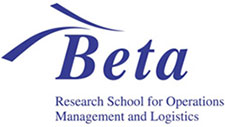Parallel Sessions
Session 9: Transportation – Chair: Martijn Mes
Vincent Karels (Eindhoven University of Technology) – Collaborative vehicle routing: challenges, models, and algorithms
Increasing competition and expectations from customers pressurizes carriers. Thus, forming collaborations is gradually becoming essential for carriers to continue their operations. In this study, we investigate an auctioning mechanism to facilitate collaboration while maintaining autonomy for the individual carriers. Multiple implementations of the auction are evaluated. Because the underlying decision problem (which is the traditional vehicle routing problem) is known to be NP–hard, this auctioning mechanism has an important inherent complexity. Therefore, we develop fast and efficient algorithms for the vehicle routing problem to be able to use the auction in operational decision making. Numerical results are presented, indicating that the auction achieves a savings potential better than the thus far reported approaches in the literature. Managerial insights are discussed, particularly related to the properties of the auction and value of the information
Arturo Pérez Rivera (University of Twente) – Integrated scheduling of drayage and long-haul transport
We study the problem of the integrated scheduling of drayage operations and long-haul transport in synchromodal transport. Although different in time span and characteristics of execution, these two processes have an impact on each other and their interaction has a direct influence on the overall performance of the transport network over time. We propose a simulation based integration of a Mixed-Integer Linear Programming (MILP) model for the drayage operations and a Markov Decision Process (MDP) model for the long-haul transport. We analyze the interfaces between these models, outline the challenges of integrating them, and design a heuristic approach to the simulation based integration. In a series of numerical experiments, we study the calibration of these components and the heuristic, and evaluate the cost savings compared to a non-integrated approach, using various transport network configurations. We discuss limitations of our model and experiments, and provide guidelines for further research for the integrated scheduling of drayage and long-haul operations in synchromodal transport.
Pieter van den Berg (Erasmus University Rotterdam) – Scheduling non-urgent patient transportation while maximizing emergency coverage
Many ambulance providers operate both advanced life support (ALS) and basic life support (BLS) ambulances. Typically, only an ALS ambulance can respond to an emergency call, whereas non-urgent patient transportation requests can either be served by an ALS or a BLS ambulance. The total capacity of BLS ambulances is usually not enough to fulfill all non-urgent transportation requests. The remaining transportation requests then have to be performed by ALS ambulances, which reduces the coverage for emergency calls. We present a model that determines the routes for BLS ambulances while maximizing the remaining coverage by ALS ambulances. Different from the classical Dial-A-Ride Problem, only one patient can be transported at a time and not all request are known in advance. Throughout the day, new requests arrive and we present an online model to deal with these requests.
